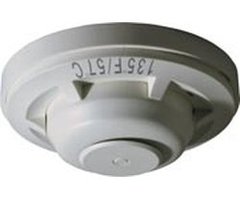At What Temperature Do Heat Alarms Trigger?
Heat Detectors react to the change in temperature caused by fire. Once the temperature rises above 135 degrees F (57 C) or 194 degrees F (90 C), the heat detector will send a signal to an alarm panel and trigger an alarm.
There are two different types of heat detectors, a fixed heat detector and a rate of rise heat detector.
A fixed temperature heat detector is designed to alarm at a set temperature. Fixed temperature heat detectors can suffer from thermal lag when fires build quickly may alarm when the room temperature is higher than the set point.
A rate of rise heat detector responds like a standard, fixed-temperature heat detector with slowly developing fires. When fires build quickly, the rate-of-rise compensation prevents thermal lag, allowing these detectors to respond when their set point is reached and will send a signal to the alarm panel if the rise of temperature is 15 degrees F (8.3 C) or more per minute. Users should verify that the space where the heat detector will be installed does not have naturally rapid temperature rises that exceed the detector’s trip point.
Once a fixed heat detector is triggered due to high temperatures, it cannot be restored and will need to be replaced. A rate of rise heat detector can be restored.
There are wireless heat detectors like the Honeywell 5809 and hardwired heat detectors like the System Sensor 5621. Both the Honeywell 5809 and System Sensor 5621 are 135 degree F fixed temperature / rate of rise heat detectors.
The Honeywell 5809 operates on One 3-volt lithium; Duracell DL123, DL123A, Panasonic CR123A battery and has the battery life is 3-5 years with approved batteries only.
Be sure to check the alarm panel’s compatibility for wireless vs hardwired devices.
Did you find this answer useful?
We offer alarm monitoring as low as $10 / month
Click Here to Learn MoreRelated Products


Related Categories
- Answered
- Answered By
- Connie Michael

